Scalar-Tensor Bianchi VI Models
Abstract
We study how may vary the gravitational and the cosmological “constants,” (G and Λ) in several scalar-tensor theories with Bianchi III, VI0, and VIh symmetries. By working under the hypothesis of self-similarity we find exact solutions for two different theoretical models, which are the Jordan-Brans-Dicke (JBD) with Λ(ϕ), and the usual JBD model with potential U(ϕ) (that mimics the behaviour of Λ(ϕ)). We compare both theoretical models, and some physical and geometrical properties of the solutions are also discussed putting special emphasis on the study of the isotropization of the solutions.
1. Introduction
Current observations of the large scale Cosmic Microwave Background (CMB) suggest to us that our physical universe is expanding in an accelerated way. Such observations [1–3] indicate that the universe is dominated by an unidentified “dark energy” (DE) and suggest that this unidentified dark energy has a negative pressure [4–6]. This last characteristic of the dark energy points to the vacuum energy or cosmological constant Λ, as a possible candidate for dark energy. From the theoretical point of view, it is convenient to consider the cosmological constant as a dynamical quantity in order to solve the so-called coincidence and fine tuning problems. In the same way other observations have pointed out a possible variation of the gravitational constant G [7, 8]. For example, observations of Hulse-Taylor binary pulsar [9, 10], and type Ia supernova observations [11]. For an extensive review see Uzan [12].
We have several theoretical models that consider both constants as variable with respect to the cosmic time. Such theories are modified general relativity (MGR), modified scalar cosmological models (MST), and several scalar-tensor theories (STT). The MGR and MST have a drawback, since in them the variations of G and Λ are introduced in an ad hoc manner. Nevertheless we consider that the STT are the best models to study the variation of G and Λ, since they have been deduced form variational principles and where the time dependence can occur in a natural way, without any new assumption or modification of the theory. This class of models has received a renewed interest in recent times, for two main reasons. Firstly, the new inflationary scenario as the extended inflation has a scalar field that solves several problems present in the old theories. Secondly, string theories and other unified theories contain a scalar field which plays a similar role to the scalar field of the STT. The scalar-tensor theories started with the work of Jordan in 1950 [13]. A prototype of such models was proposed by Brans and Dicke in 1961 [14]. Their aim for presenting this model was to modify Einstein’s theory in such a way as to incorporate the so-called “Mach principle.” These theories have been generalized by Bergmann [15], Nordtvedt [16], and Wagoner [17]. For a recent review of this class of theories we refer to [18, 19].
In a recent paper, [20] we have considered a family of scalar-tensor theories under the hypothesis of self-similarity. They are the Jordan-Brans-Dicke model with a dynamical cosmological constant (JBDΛ) [21] and with a potential (JBDU) [19], which is equivalent to a time-dependent cosmological constant. For such theoretical models, we proved how must behave each physical quantity under the hypothesis of self-similarity.
We have focused our attention on this class of solutions, since as has been pointed out by Rosquist and Jantzen [22] (for a precise definition of self similar models, see for instance [23]), self-similar models correspond to equilibrium points, playing a dominant role in the dynamics of Bianchi cosmological models. For this reason, Coley [24] has stressed the fact that self-similar models play an important role in describing the asymptotic dynamics of the Bianchi models. A large class of orthogonal spatially homogeneous models (including all class B models) are asymptotically self-similar at the initial singularity and are approximated by exact perfect fluid or vacuum self-similar power-law models. In the same way, exact self-similar power-law models can also approximate general Bianchi models at intermediate stages of their evolution and which is also important, and self-similar solutions can describe the behavior of Bianchi models at late times. Furthermore working under the hypothesis of self-similarity allows us to find exact power-law solutions in such a way that we may compare the obtained solution for each studied model.
By applying the theoretical results obtained in [20] we have studied how may vary G and Λ in the described theoretical models using different geometries as Bianchi I [25], Bianchi II [26], Bianchi V, VIIh and IX [27] and Kantowsky-Sach [20]. In this paper, enlarging the program, we would like to study the case of family of Bianchi VI geometry, that is, Bianchi III, VI 0, and VI h.
Therefore, the paper is organized as follows. In Section 2 we start by revising the theoretical results obtained in [20]. Once all the theoretical ingredients have been exposed, in Section 3 we begin describing the main results concerning to the Bianchi VI geometry and its self-similar restrictions. Section 4 is devoted to find exact self-similar solutions for the described theoretical models: JBDΛ and JBDU. We put special emphasis on the study of the isotropization of the solutions. We end in Section 5 with a brief summary of the main results and conclusions.
2. Theoretical Models
3. The Metric
Throughout the paper M will denote the usual smooth (connected, Hausdorff, fourdimensional) spacetime manifold with smooth Lorentz metric g of signature (−, +, +, +) (see, for instance, [28]). Thus M is paracompact. A comma, semicolon and the symbol ℒ denote the usual partial, covariant, and Lie derivative, respectively, the covariant derivative being with respect to the Levi-Civita connection on M derived from g. The associated Ricci and stress-energy tensors will be denoted in component form by Rij () and Tij, respectively. We will use a system of units where c = 1.
-
(1) if m = −n, then the metric collapses to Bianchi type V
(19) -
with
(20) -
and therefore ;
-
(2) if n = 0, then the metric collapses to Bianchi type III
(21) -
with the following KVF:
(22) -
and therefore ;
- (3)
if m = n = 0, then the model collapses to Bianchi I model
(23) -
with
(24) -
and .
-
(1) Model Bianchi type III (BIII), where its metric is defined by
(30) -
or
(31) -
that is, m = 0 and a2 = a3 = 1 or n = 0 and a1 = a3 = 1. With these restrictions the deceleration q, anisotropic (𝒜, 𝒲2), and gravitational entropy P2 parameters yield
(32) -
where σ2 = σijσij is the square shear and I3 = CabcdCabcd is the Weyl curvature scalar (see for instance [29]). The second Kretschmann scalar I2 is defined by I2 = RijRij; for a precise definition of gravitational entropy, see [30].
-
(2) Model Bianchi type VI 0 (BVI0), described by the metric
(33) -
with m = n, a1 = a2, and a3 = 1. The main kinematical quantities yield
(34) -
We also may define a BVI0 metric by following the way suggested by Stephani et al. [28], that is, by considering the KVF:
(35) -
with
(36) -
and therefore we obtain
(37) -
but as we have pointed out in [31], with this metric we obtain a very complicate field equation (FE), since they depend on trigonometric functions.
-
(3) To end, a Bianchi type VIh (BVIh) is defined by
(38) -
with m ≠ n, a1 ≠ a2, and a3 = 1. With these restrictions, we obtain
(39) -
where
(40) -
For the metric (18) the Einstein tensor yields
(41) -
where A = mn − m2 − n2.
4. Solutions
4.1. Model with Cosmological Constant (JBDΛ)
4.1.1. Bianchi III Solution
In the first place, we would like to stress that the cosmological constant vanishes, so this model does not describe its possible variation. By fixing the Brans-Dicke parameter, ω = 4 · 104 [32], we may see that the solution is valid for all γ ∈ (−1/3, 0), since the energy density ρ behaves as a positive decreasing time function for these values of the EoS (we have set ϕ0 > 0 for physical reasons). The solution is not inflationary for all γ ∈ (−1/3, 0), precisely q < 0 only if γ < −1/3. With regard to the anisotropic parameters, we find that the solution cannot be considered as isotropic with regard to the first anisotropic parameter, since , for all γ ∈ (−1/3, 0), that is, ; note that when γ tends to zero, 𝒜 takes the value 5/2. Nevertheless, we may say that the solution is isotropic with regard to the second anisotropic parameter, since 𝒲2 ≪ 0.0004, for all γ ∈ (−1/3, 0). The gravitational entropy P2 ∈ [0,0.2); it does not show any pathological behaviour and takes values close to zero for all γ ∈ (−1/3, 0). To end the analysis of this solution, the effective gravitational constant behaves as a time decreasing function for all γ ∈ (−1/3, 0), since for these values the parameter is positive.
4.1.2. Bianchi VI0 Solution
As we may observe, we have again obtained Λ0 = 0, which is not in agreement with the current observations and which is worse, and we cannot describe its possible time variation. The solution is only valid for all γ ∈ (−1/3, 1) = I, since for these values of the EoS, the energy density is positive, that is, ρ0 > 0. By setting the Brans-Dicke parameter, ω = 4 · 104, we find that the parameter vanishes at γc = 1/3, being positive, , for all γ ∈ (−1/3, 1/3); therefore, the effective gravitational constant Geff is decreasing when γ < 1/3, for all γ ∈ I, constant at γc = 1/3, and growing when for all γ ∈ (1/3, 1). The solution is not inflationary, since the deceleration parameter is always positive, q > 0 for all γ ∈ I. Nevertheless we may conclude that the solution is isotropic, since both anisotropic parameters are close to zero, 𝒜 ∈ (0,1), in such a way that 𝒜 → 1 only when γ → 1, while 𝒲2 ≪ 0.01, for all γ ∈ I. However, the gravitational entropy only takes values close to zero in a small neighborhood of γ = −1/3, tending to −∞ in the rest of the interval.
4.1.3. Bianchi VIh Solution
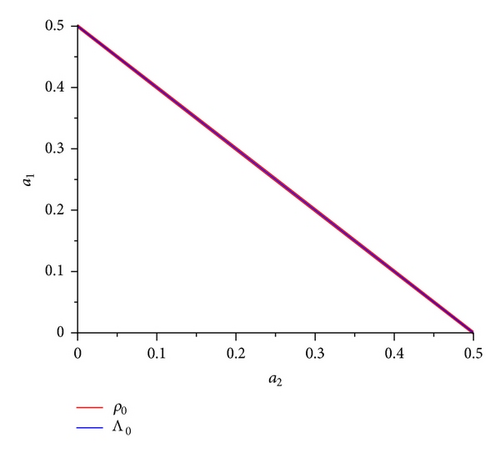
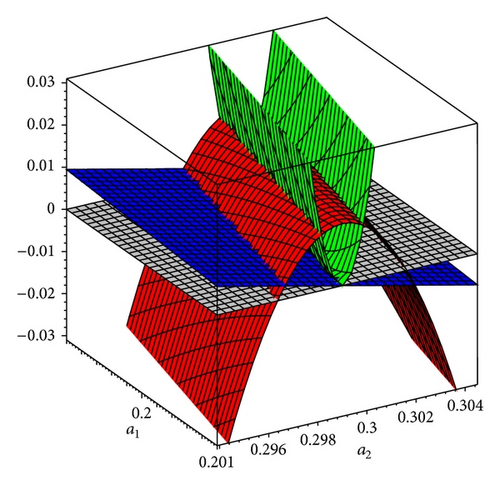
If, for example, we set a1 = 1/5, then we have obtained the following results (see Figure 3). The energy density parameter ρ0 is only positive, ρ0 > 0, if and only if a2 ∈ (0.2973605134,0.3026282371) = I1, while the cosmological constant is negative, Λ0 < 0, if and only if a2 ∈ (0.2999893937,0.3000106065) = I2, note that I2 ⊂ I1, finding that, Λ0 ≥ 0, for all a2 ∈ I1∖I2. In the same way, we may see that the parameter of the scalar field, , only vanishes, , if a2 = 0.3000106065. In this way we may arrive at the conclusion that the effective gravitational constant Geff is decreasing if a2 ∈ (0.2973605134,0.3000106065), constant at a2 = 0.3000106065, where furthermore Λ0 = 0 and G = G0, and if a2 ∈ (0.3000106065,0.3026282371), then Geff is growing and Λ0 > 0.
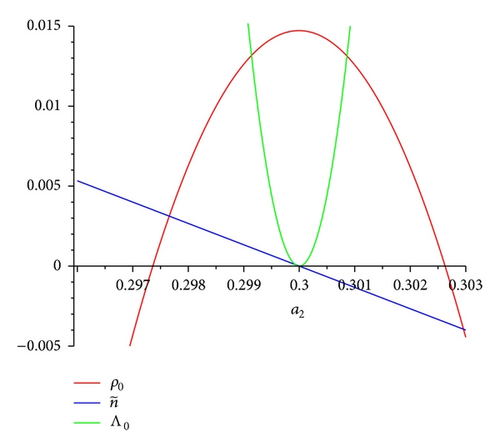
The solution is not inflationary, since the deceleration parameter q is positive in I1, and we may say that it is isotropic, since both anisotropic parameters take values close to zero (see Figure 4); only when a1 and a2 tend to zero (which is not physically realistic) we may observe that 𝒜 ≈ 0.6, while 𝒲2 ≈ 0.12. The gravitational entropy takes the following values: P2 ≈ −5 in I1.

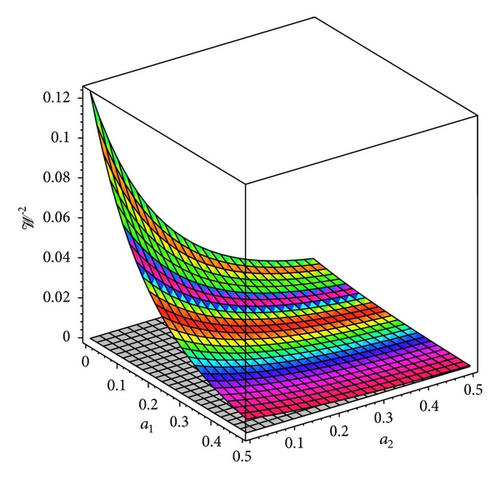
4.2. Model with Potential (JBDU)
With these FE and the conservations ones we have obtained the following solution for each of the studied cases.
4.2.1. Bianchi III Solutions
-
(1) For the first solutions we have obtained the following results:
(49) -
From the expression for γ we may obtain an exact expression for a2, getting
(50) -
and therefore we obtain the following results for the parameters and q:
(51) -
Therefore, we begin by studying the set of points where the scale factor a2 vanishes, so
(52) -
and, in the same way, we calculate the set of values where the parameters vanish. The numerical analysis performed shows us that the energy density is only positive in a small tubular neighborhood with γ ∈ (−1/3,0) and m ∈ (−1,1). In the same neighborhood the potential U and the parameter vanish (see Figure 5).
-
If, for example, we set m = 1/5 and the Brans-Dicke parameter, ω = 4 · 104, we may see in Figure 6 that the solution is only valid for all γ ∈ (−0.3311865733, −0.3264562742) = ℰ(γc), that is, a neighborhood of a critical value of the EoS γc = −0.328, since the energy density only is positive in this neighborhood, ρ0 > 0, where furthermore the scalar field is also positive, ϕ0 > 0 (see Figure 6). In this interval the potential function (the cosmological constant) behaves as follow: U0 = 0 if and only if γ1 = −0.3288254637, and γ2 = −0.3288130902, in such a way that U0 ≤ 0, for all γ ∈ (γ1, γ2), being positive in the rest of the interval. The parameter of the scalar field vanishes at γ2, being if γ < γ2 and if γ > γ2; therefore, the effective gravitational constant decreases if γ < γ2 is constant at γ = γ2 and is growing when γ > γ2, for all γ ∈ ℰ(γc).
-
The solution is not inflationary, since q > 0 for all γ ∈ (−1/3,0) and m ∈ (−1,1). To end, we may say that the solution isotropizes since 𝒜 → 0 and 𝒲2 ≪ 0.0001. In the same way we conclude that the gravitational entropy takes values very close to zero in the interval ℰ(γc).
-
(2) In the second solution we get U0 = 0. This solution is equal to the obtained one in the case of JBDΛ, so the conclusions are the same as the obtained ones in such case.

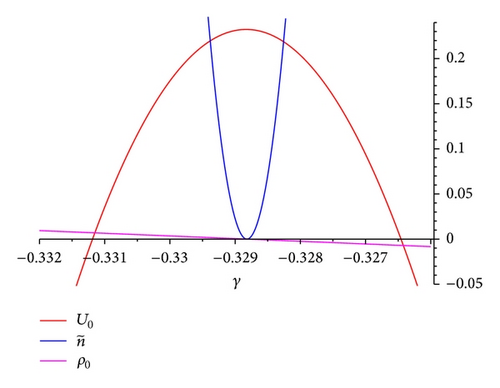
4.2.2. Bianchi VI0 Solutions
-
(1) In the first of them we get a1 = a2, a3 = 1, m = n, and U0 ≠ 0, obtaining
(53) -
From the expression of γ, we get a2:
(54) -
where
(55) -
and therefore
(56) -
As mentioned above, we need to perform a numerical analysis to analyze the solution. With ω = 4 · 104, we find that the quantities only vanish in a tubular neighborhood, being the solution valid if a2 ∈ (0,1) and n ∈ (−1/2,1/2) as it is shown in Figure 7.
-
If, for example, we set n = 1/3, then we may understand how each quantity behaves. The energy density is only positive, ρ0 > 0, in the interval for all γ ∈ (0.12584,0.12879) = ℰ(γc) = I, that is, in a small neighborhood of the critical value of the EoS γc = 0.1273. As we can see in Figure 8 in such interval the scalar field is also positive ϕ0 > 0. The potential U behaves as follows: U0 = 0 if and only if γ1 = 0.127322 and γ2 = 0.127325, so U0 ≤ 0, for all γ ∈ (γ1, γ2) = I2, and therefore U > 0, for all γ ∈ I∖I2.
-
The parameter vanishes at γ1 in such a way that if γ < γ1 and if γ > γ1; therefore, the effective gravitational constant Geff behaves as a growing time function if γ < γ1, and it is constant at γ = γ1 and is decreasing if γ > γ1, for all γ ∈ ℰ(γc). The solution is not inflationary, q > 0 for all a2 ∈ (0,1) and n ∈ (−1/2,1/2). With regard to the isotropization of the solution, we reach the conclusion that it isotropizes, since 𝒜 → 0, and 𝒲2 ≪ 0.035 for all a2 ∈ (0,1) and n ∈ (−1/2,1/2). In the same way, the gravitational entropy takes values very close to zero.
-
(2) With regard to the second solution, we have obtained U0 = 0, and therefore it is similar to the obtained one in the model JBDΛ.
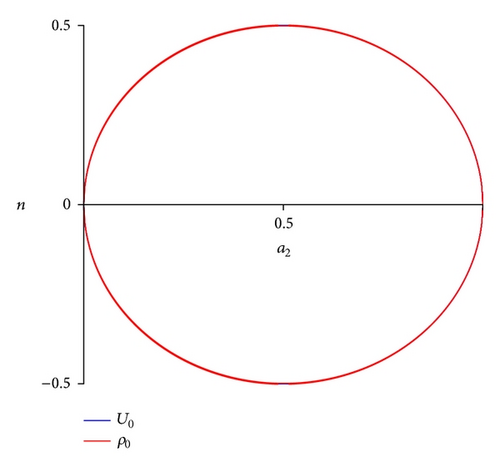
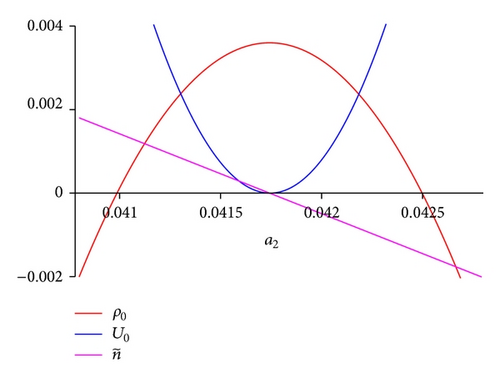
4.2.3. Bianchi VIh Solution
5. Conclusions
We have studied how may vary the “constants” G and Λ (or U) in two different scalar-tensor models: the JBD model with Λ and the JBD model with potential U. Under the hypothesis of self-similarity we have been able to obtain exact solutions for the Bianchi VI geometry (including types III, VI 0, and VI h), which allow us to compare them. We have reached the conclusion that the possible variation of the cosmological constant is better described within the JBDU theoretical framework, since with the JBDΛ model Λ usually vanishes. We have summarized in Table 1 the set of solutions that we have found for both models, JBDΛ and JBDU.
| Model | Λ | U | |
|---|---|---|---|
| III | Λ = 0, G↘, γ ∈ (−1/3,0) | ⇔ | U = 0, (case Λ) |
| III | U > 0, G ~ G(γc, m) γ ∈ (−1/3,0) 𝒜 | ||
| VI0 | Λ = 0, G ~ G(γ), γ ∈ (−1/3,1) 𝒜 | ⇔ | U = 0, (case Λ) |
| VI0 | U > 0, G ~ G(a2, n) γ ∈ (−1/3,1) 𝒜 | ||
| VIh | Λ > 0, G ~ G(a1, a2), γ = 1/3 𝒜 | ⇔ | U > 0, G ~ G(a1, a2), γ = 1/3 𝒜 |
With regard to the first of the studied models, the JBDΛ, we have been able to obtain a solution for each geometry. The first of them (Bianchi III) is only valid for all γ ∈ (−1/3,0) and predicts that the cosmological constant vanishes, Λ = 0, which is in contradiction with the current observations. Nevertheless we have studied this solution reaching the conclusion that it is noninflationary and does not isotropize with respect to the first anisotropic parameter 𝒜. The effective gravitational constant Geff is always decreasing for all γ ∈ (−1/3,0). In the case of the Bianchi type VI 0 we have found that the cosmological constant is also zero, Λ = 0, but the solution is valid for all γ ∈ (−1/3,1). The effective gravitational constant Geff shows a different behaviour depending on the EoS γ. It may be growing if γ > 1/3, constant at γ = 1/3, and it behaves as a decreasing time function if γ < 1/3, where γ ∈ (−1/3,1). The solution isotropizes, and it is noninflationary. The solution obtained for the model Bianchi type VI h has a nonzero cosmological constant, Λ ≠ 0, but the solution is only valid for a particular value of the EoS, γ = 1/3. It is also noninflationary, and it isotropizes. The numerical analysis carryout shows us that the solution is only valid in a small tubular neighborhood, where a1, a2 ∈ (0,1/2) in fact the amplitude of this neighborhood depends on the value of the Brans-Dicke parameter ω in such a way that if future observations fix an upper limit for this constant then the diameter of this tubular neighborhood will be small. In this tubular neighborhood, the energy density is positive as well as the cosmological constant Λ. However, there is a really small subtubular neighborhood where Λ vanishes, or it is negative. In this way we have concluded that the solution predicts a Λ > 0 (except within this subtubular neighborhood) in agreement with the observations, while the effective gravitational constant may be growing, constant at a critical point γc (where the parameter vanishes), and decreasing.
With regard to the model with potential, JBDU, we have obtained solutions similar to the obtained ones in the model JBDΛ, and therefore we have reached the same conclusions. Nevertheless we have also obtained other solutions which predict a nonvanishing cosmological constant, in this case U ≠ 0, for the geometries Bianchi types III and VI 0. In the case of the Bianchi type III, the solution is only valid in a small tubular neighborhood, where γ ∈ (−1/3,0) and m ∈ (−1,1). In this tubular neighborhood the energy density is positive, and the solution predicts that the potential function U (that mimics the behaviour of the cosmological constant) is also positive except in a very small subtubular neighborhood where it is negative or vanishes. Within this neighborhood the effective gravitational constant may be growing, constant at a critical point γc (where the parameter vanishes), or decreasing depending of the values of γ and n. To end, the solution found for the model Bianchi type VI 0 with U ≠ 0 is only valid in a small tubular neighborhood, where a2 ∈ (0,1) and n ∈ (−1/2,1/2), it is noninflationary and isotropizes. In this neighborhood the quantities ρ, U, and Geff show similar behaviour as the described ones in this kind of solutions, that is, ρ > 0, U > 0 (except in a small subtubular neighborhood), and Geff is growing, constant, or decreasing depending on the parameters a2 and n.




